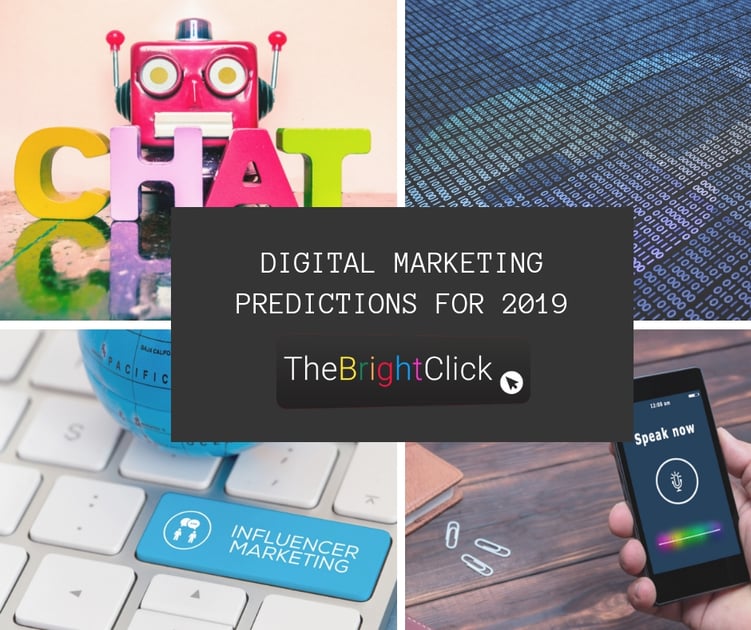Digital Marketing Predictions For 2019
January 2, 2019 •Claire Archer-Davis


Thanks to the rise of intelligent assistant devices such as Amazon’s Alexa, and Google Home flooding people’s houses and offices, voice search has become more popular than ever. It is predicted that 30% of all web browsing will be down by voice by the year 2020, and 2019 will be the gateway to that. When it comes to interacting with customers, it is thought that similar intelligent assistants and voice search will be used more and more this year too.
Chatbots
Gone are the days of annoying MSN messenger chatbots and clunky, confusing conversations, chatbots are making their way to the forefront over mobile apps for 2019. Chatbots means users don’t have to take up storage space by downloading an app, and interacting with them is quicker, and more intuitive too. Perfect for selling and purchasing, chatbots bring the POS to the customer directly, rather than mobile apps which only show products to customers and the time spent looking can decrease the likelihood of a conversion. It is estimated that by 2020 chatbots will account for 85% of all B2C interactions.
Visual Recognition
We all know that images are the key to catching a customer or potential customers interest, but with visual recognition in 2019 businesses and websites will be able to learn a lot more about what works and what doesn’t in regards to customer impact in advertising. Cookies which are used to track user visits to a website or webpage can now be used to monitor behaviour in relation to how customers interact with images. For example, being able to see and recognise that when a customer sees a particular picture, they are more likely to click through to your website and buy the product shown will be vital to how digital advertising is done in 2019. Visual recognition will lead to much more precise targeting when it comes to customer demographics.
Security
Security has been a real hot topic over the past few years, and customers are now getting savvier than ever when it comes to their personal information and how it is used by companies and businesses online. Last year the General Data Protection Regulation (GDPR) took effect in Europe meaning that consumers took more interest and paid more attention to how companies and websites handled their information and this interest is expected to grow in 2019. While all you can do is be a responsible business when it comes to customer security; it is essential to talk to your customers about the steps you are taking to protect their information.
Vertical video
Video is, of course, getting bigger and bigger, which is great for advertisers and video can provide such a wealth of information to customers in such a short space of time. Better than photos or text at conveying a message, video will not only continue to grow online, but it will move to more vertical video content as mobile users become reluctant to turn their devices on their sides. Websites and apps such as Tik Tok, and Instagram’s new IGTV feature show videos vertically in full-screen, rather than requiring the user to turn their phone or tablet horizontally.
Visual Search
We’ve already discussed the rise of voice search, but in 2019 visual search is getting its moment. Your customers and consumers are likely to always have a smartphone or tablet in their hands, so why not take advantage of visual search which allows users to take a photo of something and then to learn information about it. Pinterest’s Lens feature was released last year to much success, and Amazon and Google have allowed image searches for years.
Real, authentic people
In 2018 we saw businesses distancing themselves from big celebrities and Hollywood names when it comes to advertising, because they aren’t relatable to their target audiences, and in 2019 we are likely to see more of the same. Instead of big names and well-known faces, more ordinary people (known as micro-influencers) who are mothers, office workers and service people are more likely to appeal to your customers and pique their interest. If a customer can see something relatable in your advertising, then they are more likely to give your product or service a try.
Online stories
For a year or so now the world has been trying to use Snapchat to advertise to customers or at least offer a unique snapshot into your business, but something just hasn’t been quite right – the appeal of quick and messy content is a big bonus for companies who want to show that they are real people and not just a faceless corporation, but Snapchat is just too singular. Now thanks to Instagram and Facebook stories, companies can integrate these quick unpolished updates into their regular Facebook and Instagram strategies, and we expect these platforms to grow even more in 2019.
Featured Articles
Categories
- advertising (2)
- Adwords (6)
- AFC Bournemouth (1)
- B2B (2)
- baby (1)
- Back to Gym (1)
- BBC (1)
- Beautiful South (1)
- blog (1)
- Blog Posts (64)
- Blogging (8)
- BLogs (1)
- Brand Visibility (1)
- Business (37)
- Business TImeline (6)
- Care Home Website (1)
- Chance (1)
- charity (1)
- Check-In (1)
- Cover Image (1)
- Customer Engagement (10)
- customer service (7)
- Design (2)
- Digital Marketing (18)
- Email (5)
- Estate Agent Social Media Marketing (3)
- Facebook (32)
- SEO (3)
